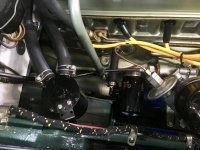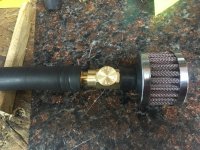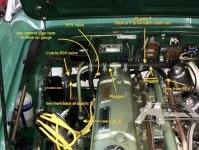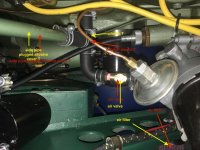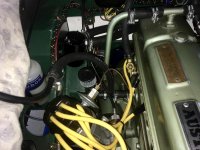first of all AJ, sorry if we hijacked this thread. hope your questions got answered.
steve broke this down in to top of engine and side of engine.
top of engine or vacuum side.
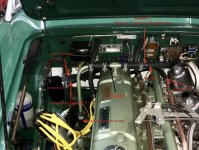
you can see i put a plastic T in the line from the valve cover to the carb. i could have used an elbow or gotten a U shaped hose to run directly to my oil catch can. i chose the current setup because it looks closest to the original. the plastic T has a rubber plug glued in the side with the hose to the carb. the hose to the Carb gives it a little more stiffness. From the back of the T, the line wraps around behind the valve cover and to my oil catch can. then comes out of the oil catch can with 5/8 hose to the PCV valve. then on to the copper line i have going to my vac port on the front manifold.
Note: the left side of the green metal T on top of the valve cover is also plugged with a rubber plug. did not want to pull air up the side pipe. picked both rubber plugs up at Lowes.
shows rubber plug in valve cover T. forget hose on right side of T, it was changed like pic above with plastic T in it.
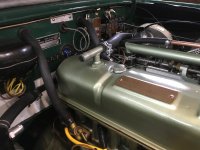
side cover or air inlet side:
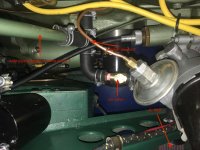
you can see my air filter at the bottom right. i moved it there to get it out of the way plus i was afraid it would shake too much with the weight. when i ran it thru the hole in the brace, i made a little bracket to hold it steady. also holds the valve steady. the brass has a little weight to it. i did use a number of hose clamps. i had a few laying around from a MG car kit.
like i said before, the filter alone gave me no reading on the vacuum gauge which is why i added the valve. i think it was 3 bucks at HF. i also put a screw in the oil cap to seal that vent hole and sealed the dipstick with a little seal i made and a couple o-rings below it.
once together i pulled the top of the side pipe out of the hose (first pic left side of metal T on valve cover) connecting the gauge there. i felt connecting it to the top of the side pipe gave me a more real reading figuring my dipstick might leak a little. but you can also check the vacuum at the dipstick tube.
then i just adjusted my valve to give me just under 1" HG on my gauge. pulled the gauge off and connected the top of the side pipe back to the hose at the metal valve cover T. of course i did a little testing in there first.
hope this answers all questions. if not i can try again. i get in too big a hurry trying to explain things... i know.

 Hi Guest!
Hi Guest!

 smilie in place of the real @
smilie in place of the real @
 Pretty Please - add it to our Events forum(s) and add to the calendar! >>
Pretty Please - add it to our Events forum(s) and add to the calendar! >> 

